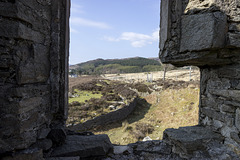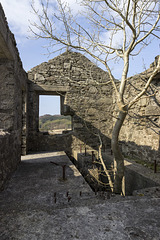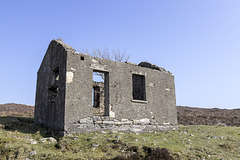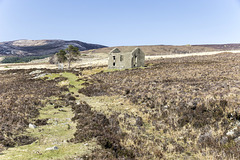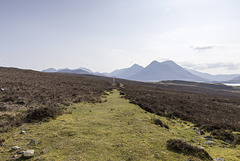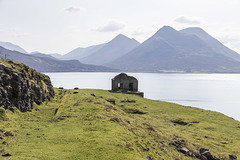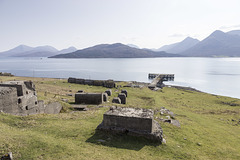
Scotland - Raasay
Folder: Scotland
Photos of the Inner Hebrides island of Raasay, Scotland.
Raasay: Churchton Bay, Ferry, and Ben Tianavaig on…
| |
|
A view of Churchton Bay at Clachan on Raasay, taken from the old ironstone mine tramway. The ferry is just departing from the terminal bound for Sconser.
Ben Tianavaig on Skye forms an impressive backdrop.
Raasay: Churchton Bay and Ben Tianavaig on Skye
| |
|
A view of Churchton Bay at Clachan on Raasay, taken from the old ironstone mine tramway. The long sunlit building to the right of centre of the photo is the modern Inverarish Community Centre.
Ben Tianavaig on Skye forms an impressive backdrop.
Raasay: Inverarish from mine tramway
| |
|
A view of Inverarish and Churchton Bay taken from the old ironstone mine tramway. The buildings in the foreground are Inverarish Terrace, built by William Baird & Co. to house the mine workers, many of whom were German prisoners of war. The long sunlit building in the centre of the photo is the modern Inverarish Community Centre.
The distant hills are on Skye.
Raasay: No.1 Ironstone Mine adit entrance (intake)…
| |
|
|
|
Raasay Ironstone Mine and Processing Works
A photo taken through the steel grille across the intake adit entrance of the Raasay No.1 Ironstone Mine, taken in April 2019. The concrete block walls extend just a short distance in, thereafter it is natural stone with few supports. There were two entrances for the No.1 Mine; this one allowed fresh air into the mine and was the main haulage road for ore. The link below shows the mine entrance in 1917.
The other adit for return (exhaust) air and its ventilation fan was located a short distance away.
Background
The two adits of Raasay No.1 ironstone Mine were situated about 2.5 km north of East Suisnish pier and worked the Jurassic (Upper Lias) age siderite and chamosite ores from 1914 to 1920. The mine was owned and developed by William Baird & Co. who also built the terraces of houses in the village of Inverarish to house the mine workers, many of whom were German prisoners of war. A tramway and incline connected the mine to the processing works (crusher, calcining kilns, gantries, loading hoppers) at East Suisnish.
A second pair of mine adits (Raasay No.2 Ironstone Mine) just north of Inverarish were also opened up around the same time but never went into proper production due to geological difficulties (faulting).
There was also a small amount of opencast outcrop mining carried out near the No.1 Mine, again around the same time.
The works were dismantled by 1943 but the site is now a scheduled protected monument.
A view of the No.1 Mine in 1917 is here:
geoscenic.bgs.ac.uk/asset-bank/action/viewAsset?id=1338
Raasay: No.1 Ironstone Mine adit entrance (intake)…
| |
|
|
Raasay Ironstone Mine and Processing Works
A closer view of the intake adit entrance of the Raasay No.1 Ironstone Mine, taken in April 2019. There were two entrances for the No.1 Mine; this one allowed fresh air into the mine and was the main haulage road for ore. The link below shows the mine entrance in 1917.
The other adit for return (exhaust) air and its ventilation fan was located a short distance away.
Background
The two adits of Raasay No.1 ironstone Mine were situated about 2.5 km north of East Suisnish pier and worked the Jurassic (Upper Lias) age siderite and chamosite ores from 1914 to 1920. The mine was owned and developed by William Baird & Co. who also built the terraces of houses in the village of Inverarish to house the mine workers, many of whom were German prisoners of war. A tramway and incline connected the mine to the processing works (crusher, calcining kilns, gantries, loading hoppers) at East Suisnish.
A second pair of mine adits (Raasay No.2 Ironstone Mine) just north of Inverarish were also opened up around the same time but never went into proper production due to geological difficulties (faulting).
There was also a small amount of opencast outcrop mining carried out near the No.1 Mine, again around the same time.
The works were dismantled by 1943 but the site is now a scheduled protected monument.
A view of the No.1 Mine in 1917 is here:
geoscenic.bgs.ac.uk/asset-bank/action/viewAsset?id=1338
Raasay: No.1 Ironstone Mine adit entrance (intake)…
| |
|
|
Raasay Ironstone Mine and Processing Works
This is the intake adit entrance of the Raasay No.1 Ironstone Mine, taken in April 2019. There were two entrances for the No.1 Mine; this one allowed fresh air into the mine and was the main haulage road for ore. The link below shows the mine entrance in 1917.
The other adit for return (exhaust) air and its ventilation fan was located a short distance away.
Background
The two adits of Raasay No.1 ironstone Mine were situated about 2.5 km north of East Suisnish pier and worked the Jurassic (Upper Lias) age siderite and chamosite ores from 1914 to 1920. The mine was owned and developed by William Baird & Co. who also built the terraces of houses in the village of Inverarish to house the mine workers, many of whom were German prisoners of war. A tramway and incline connected the mine to the processing works (crusher, calcining kilns, gantries, loading hoppers) at East Suisnish.
A second pair of mine adits (Raasay No.2 Ironstone Mine) just north of Inverarish were also opened up around the same time but never went into proper production due to geological difficulties (faulting).
There was also a small amount of opencast outcrop mining carried out near the No.1 Mine, again around the same time.
The works were dismantled by 1943 but the site is now a scheduled protected monument.
A view of the No.1 Mine in 1917 is here:
geoscenic.bgs.ac.uk/asset-bank/action/viewAsset?id=1338
Raasay: No.1 Ironstone Mine tramway with silver bi…
| |
|
|
Raasay Ironstone Mine and Processing Works
Just north of the viaduct in the previous photos, the No.1 Mine tramway is now overgrown with an attractive double lining of silver birch trees.
Background
The two adits of Raasay No.1 ironstone Mine were situated about 2.5 km north of East Suisnish pier and worked the Jurassic (Upper Lias) age siderite and chamosite ores from 1914 to 1920. The mine was owned and developed by William Baird & Co. who also built the terraces of houses in the village of Inverarish to house the mine workers, many of whom were German prisoners of war. A tramway and incline connected the mine to the processing works (crusher, calcining kilns, gantries, loading hoppers) at East Suisnish.
A second pair of mine adits (Raasay No.2 Ironstone Mine) just north of Inverarish were also opened up around the same time but never went into proper production due to geological difficulties (faulting).
There was also a small amount of opencast outcrop mining carried out near the No.1 Mine, again around the same time.
The works were dismantled by 1943 but the site is now a scheduled protected monument.
A view of the works in 1917 is here:
geoscenic.bgs.ac.uk/asset-bank/action/viewAsset?id=1343
Raasay: No.1 Mine tramway viaduct and tributary bu…
| |
|
|
Raasay Ironstone Mine and Processing Works
The No.1 Mine tramway had to cross the steep sided valley of a tributary of the Inverarish Burn on an impressive viaduct before heading south towards the processing plant at East Suisnish. Only the concrete support piers remain today. This is a view from the west.
Background
The two adits of Raasay No.1 ironstone Mine were situated about 2.5 km north of East Suisnish pier and worked the Jurassic (Upper Lias) age siderite and chamosite ores from 1914 to 1920. The mine was owned and developed by William Baird & Co. who also built the terraces of houses in the village of Inverarish to house the mine workers, many of whom were German prisoners of war. A tramway and incline connected the mine to the processing works (crusher, calcining kilns, gantries, loading hoppers) at East Suisnish.
A second pair of mine adits (Raasay No.2 Ironstone Mine) just north of Inverarish were also opened up around the same time but never went into proper production due to geological difficulties (faulting).
There was also a small amount of opencast outcrop mining carried out near the No.1 Mine, again around the same time.
The works were dismantled by 1943 but the site is now a scheduled protected monument.
A view of the works in 1917 is here:
geoscenic.bgs.ac.uk/asset-bank/action/viewAsset?id=1343
Raasay: No.1 Mine tramway viaduct - north pier
| |
|
|
Raasay Ironstone Mine and Processing Works
The No.1 Mine tramway had to cross the steep sided valley of a tributary of the Inverarish Burn on an impressive viaduct before heading south towards the processing plant at East Suisnish. Only the concrete support piers remain today. This is a view of the northern pier.
Background
The two adits of Raasay No.1 ironstone Mine were situated about 2.5 km north of East Suisnish pier and worked the Jurassic (Upper Lias) age siderite and chamosite ores from 1914 to 1920. The mine was owned and developed by William Baird & Co. who also built the terraces of houses in the village of Inverarish to house the mine workers, many of whom were German prisoners of war. A tramway and incline connected the mine to the processing works (crusher, calcining kilns, gantries, loading hoppers) at East Suisnish.
A second pair of mine adits (Raasay No.2 Ironstone Mine) just north of Inverarish were also opened up around the same time but never went into proper production due to geological difficulties (faulting).
There was also a small amount of opencast outcrop mining carried out near the No.1 Mine, again around the same time.
The works were dismantled by 1943 but the site is now a scheduled protected monument.
A view of the works in 1917 is here:
geoscenic.bgs.ac.uk/asset-bank/action/viewAsset?id=1343
Raasay: No.1 Mine tramway viaduct piers
| |
|
|
Raasay Ironstone Mine and Processing Works
The No.1 Mine tramway had to cross the steep sided valley of a tributary of the Inverarish Burn on an impressive viaduct before heading south towards the processing plant at East Suisnish. Only the concrete support piers remain today.
Background
The two adits of Raasay No.1 ironstone Mine were situated about 2.5 km north of East Suisnish pier and worked the Jurassic (Upper Lias) age siderite and chamosite ores from 1914 to 1920. The mine was owned and developed by William Baird & Co. who also built the terraces of houses in the village of Inverarish to house the mine workers, many of whom were German prisoners of war. A tramway and incline connected the mine to the processing works (crusher, calcining kilns, gantries, loading hoppers) at East Suisnish.
A second pair of mine adits (Raasay No.2 Ironstone Mine) just north of Inverarish were also opened up around the same time but never went into proper production due to geological difficulties (faulting).
There was also a small amount of opencast outcrop mining carried out near the No.1 Mine, again around the same time.
The works were dismantled by 1943 but the site is now a scheduled protected monument.
A view of the works in 1917 is here:
geoscenic.bgs.ac.uk/asset-bank/action/viewAsset?id=1343
Raasay: Tramway junction
| |
|
|
Raasay Ironstone Mine and Processing Works
This is the point where the No.2 Mine tramway joins the No.1 Mine tramway before heading south towards the processing plant at East Suisnish. The ruined building is the remains of the No.2 tramway winding house. The mountains of Skye are in the distance.
Background
The two adits of Raasay No.1 ironstone Mine were situated about 2.5 km north of East Suisnish pier and worked the Jurassic (Upper Lias) age siderite and chamosite ores from 1914 to 1920. The mine was owned and developed by William Baird & Co. who also built the terraces of houses in the village of Inverarish to house the mine workers, many of whom were German prisoners of war. A tramway and incline connected the mine to the processing works (crusher, calcining kilns, gantries, loading hoppers) at East Suisnish.
A second pair of mine adits (Raasay No.2 Ironstone Mine) just north of Inverarish were also opened up around the same time but never went into proper production due to geological difficulties (faulting).
There was also a small amount of opencast outcrop mining carried out near the No.1 Mine, again around the same time.
The works were dismantled by 1943 but the site is now a scheduled protected monument.
A view of the works in 1917 is here:
geoscenic.bgs.ac.uk/asset-bank/action/viewAsset?id=1343
The No.2 Mine entrances in 1917 are shown here:
geoscenic.bgs.ac.uk/asset-bank/action/viewAsset?id=1341
Raasay: No.2 Mine tramway view from winding house…
| |
|
Raasay Ironstone Mine and Processing Works
This is a view from the No.2 Mine tramway winding house, The tramway and shallow incline runs parallel to the modern fence to the No.2 Mine which was situated in the wooded area in the distance.
Background
The two adits of Raasay No.1 ironstone Mine were situated about 2.5 km north of East Suisnish pier and worked the Jurassic (Upper Lias) age siderite and chamosite ores from 1914 to 1920. The mine was owned and developed by William Baird & Co. who also built the terraces of houses in the village of Inverarish to house the mine workers, many of whom were German prisoners of war. A tramway and incline connected the mine to the processing works (crusher, calcining kilns, gantries, loading hoppers) at East Suisnish.
A second pair of mine adits (Raasay No.2 Ironstone Mine) just north of Inverarish were also opened up around the same time but never went into proper production due to geological difficulties (faulting).
There was also a small amount of opencast outcrop mining carried out near the No.1 Mine, again around the same time.
The works were dismantled by 1943 but the site is now a scheduled protected monument.
A view of the works in 1917 is here:
geoscenic.bgs.ac.uk/asset-bank/action/viewAsset?id=1343
The No.2 Mine entrances in 1917 are shown here:
geoscenic.bgs.ac.uk/asset-bank/action/viewAsset?id=1341
Raasay: No.2 Mine tramway winding house interior
| |
|
Raasay Ironstone Mine and Processing Works
This ruined building was the winding house for the separate tramway up from the No.2 Mine which then joins the main tramway route close to this point. The tree is growing out of the winding wheel pit. The winding ropes passed through the 'L'-shaped hole in the far wall. The No.2 Mine was situated in the wooded area in the far distance.
Background
The two adits of Raasay No.1 ironstone Mine were situated about 2.5 km north of East Suisnish pier and worked the Jurassic (Upper Lias) age siderite and chamosite ores from 1914 to 1920. The mine was owned and developed by William Baird & Co. who also built the terraces of houses in the village of Inverarish to house the mine workers, many of whom were German prisoners of war. A tramway and incline connected the mine to the processing works (crusher, calcining kilns, gantries, loading hoppers) at East Suisnish.
A second pair of mine adits (Raasay No.2 Ironstone Mine) just north of Inverarish were also opened up around the same time but never went into proper production due to geological difficulties (faulting).
There was also a small amount of opencast outcrop mining carried out near the No.1 Mine, again around the same time.
The works were dismantled by 1943 but the site is now a scheduled protected monument.
A view of the works in 1917 is here:
geoscenic.bgs.ac.uk/asset-bank/action/viewAsset?id=1343
The No.2 Mine entrances in 1917 are shown here:
geoscenic.bgs.ac.uk/asset-bank/action/viewAsset?id=1341
Raasay: No.2 Mine tramway winding house
| |
|
Raasay Ironstone Mine and Processing Works
This ruined building was the winding house for the separate tramway up from the No.2 Mine (off to the left) which then joins the main tramway route close to this point.
Background
The two adits of Raasay No.1 ironstone Mine were situated about 2.5 km north of East Suisnish pier and worked the Jurassic (Upper Lias) age siderite and chamosite ores from 1914 to 1920. The mine was owned and developed by William Baird & Co. who also built the terraces of houses in the village of Inverarish to house the mine workers, many of whom were German prisoners of war. A tramway and incline connected the mine to the processing works (crusher, calcining kilns, gantries, loading hoppers) at East Suisnish.
A second pair of mine adits (Raasay No.2 Ironstone Mine) just north of Inverarish were also opened up around the same time but never went into proper production due to geological difficulties (faulting).
There was also a small amount of opencast outcrop mining carried out near the No.1 Mine, again around the same time.
The works were dismantled by 1943 but the site is now a scheduled protected monument.
A view of the works in 1917 is here:
geoscenic.bgs.ac.uk/asset-bank/action/viewAsset?id=1343
Raasay: view north along ironstone mine tramway
| |
|
Raasay Ironstone Mine and Processing Works
This is a norththwards view along the tramway which brought ore down from the mine adits to the processing plant. The camera location is about 1.4 km from the processing plant. The ruined building was the winding house for the separate tramway (of to the left) up from the No.2 Mine to the left) which then joins the main tramway route close to this point.
Background
The two adits of Raasay No.1 ironstone Mine were situated about 2.5 km north of East Suisnish pier and worked the Jurassic (Upper Lias) age siderite and chamosite ores from 1914 to 1920. The mine was owned and developed by William Baird & Co. who also built the terraces of houses in the village of Inverarish to house the mine workers, many of whom were German prisoners of war. A tramway and incline connected the mine to the processing works (crusher, calcining kilns, gantries, loading hoppers) at East Suisnish.
A second pair of mine adits (Raasay No.2 Ironstone Mine) just north of Inverarish were also opened up around the same time but never went into proper production due to geological difficulties (faulting).
There was also a small amount of opencast outcrop mining carried out near the No.1 Mine, again around the same time.
The works were dismantled by 1943 but the site is now a scheduled protected monument.
A view of the works in 1917 is here:
geoscenic.bgs.ac.uk/asset-bank/action/viewAsset?id=1343
Raasay: view south along ironstone mine tramway
| |
|
Raasay Ironstone Mine and Processing Works
This is a southwards view along the tramway which brought ore down from the mine adits to the processing plant. The camera location is about 1.4 km from the processing plant. A separate tramway up from the No.2 Mine joins the main tramway route close to this point.
The Cuillin mountains of Skye are in the background.
Background
The two adits of Raasay No.1 ironstone Mine were situated about 2.5 km north of East Suisnish pier and worked the Jurassic (Upper Lias) age siderite and chamosite ores from 1914 to 1920. The mine was owned and developed by William Baird & Co. who also built the terraces of houses in the village of Inverarish to house the mine workers, many of whom were German prisoners of war. A tramway and incline connected the mine to the processing works (crusher, calcining kilns, gantries, loading hoppers) at East Suisnish.
A second pair of mine adits (Raasay No.2 Ironstone Mine) just north of Inverarish were also opened up around the same time but never went into proper production due to geological difficulties (faulting).
There was also a small amount of opencast outcrop mining carried out near the No.1 Mine, again around the same time.
The works were dismantled by 1943 but the site is now a scheduled protected monument.
A view of the works in 1917 is here:
geoscenic.bgs.ac.uk/asset-bank/action/viewAsset?id=1343
Raasay: Ironstone processing works - southern end…
| |
|
Raasay Ironstone Mine and Processing Works
This is a view from the last section of the tramway which brought ore down from the mine adits to the processing plant. The tramway disappears out of view as it drops steeply down the incline to the processing plant.
The Red Cuillin mountains of Skye are in the background.
Background
The two adits of Raasay No.1 ironstone Mine were situated about 2.5 km north of East Suisnish pier and worked the Jurassic (Upper Lias) age siderite and chamosite ores from 1914 to 1920. The mine was owned and developed by William Baird & Co. who also built the terraces of houses in the village of Inverarish to house the mine workers, many of whom were German prisoners of war. A tramway and incline connected the mine to the processing works (crusher, calcining kilns, gantries, loading hoppers) at East Suisnish.
A second pair of mine adits (Raasay No.2 Ironstone Mine) just north of Inverarish were also opened up around the same time but never went into proper production due to geological difficulties (faulting).
There was also a small amount of opencast outcrop mining carried out near the No.1 Mine, again around the same time.
The works were dismantled by 1943 but the site is now a scheduled protected monument.
A view of the works in 1917 is here:
geoscenic.bgs.ac.uk/asset-bank/action/viewAsset?id=1343
Raasay: Ironstone processing works - view down inc…
| |
|
|
Raasay Ironstone Mine and Processing Works
This is a view down the incline on the last section of the tramway which brought ore down from the mine adits to the processing plant.
The concrete blocks in the foreground are part of the crusher house foundations and just below centre are the gantry supports from which ore would have been transported from the crusher to be fed into the calcining kilns. The gantry and crusher house can be seen in the 1917 photo in the link below. East Suisnish pier and the mountains of Skye are in the background.
Background
The two adits of Raasay No.1 ironstone Mine were situated about 2.5 km north of East Suisnish pier and worked the Jurassic (Upper Lias) age siderite and chamosite ores from 1914 to 1920. The mine was owned and developed by William Baird & Co. who also built the terraces of houses in the village of Inverarish to house the mine workers, many of whom were German prisoners of war. A tramway and incline connected the mine to the processing works (crusher, calcining kilns, gantries, loading hoppers) at East Suisnish.
A second pair of mine adits (Raasay No.2 Ironstone Mine) just north of Inverarish were also opened up around the same time but never went into proper production due to geological difficulties (faulting).
There was also a small amount of opencast outcrop mining carried out near the No.1 Mine, again around the same time.
The works were dismantled by 1943 but the site is now a scheduled protected monument.
A view of the works in 1917 is here:
geoscenic.bgs.ac.uk/asset-bank/action/viewAsset?id=1343
Jump to top
RSS feed- Latest items - Subscribe to the latest items added to this album
- ipernity © 2007-2025
- Help & Contact
|
Club news
|
About ipernity
|
History |
ipernity Club & Prices |
Guide of good conduct
Donate | Group guidelines | Privacy policy | Terms of use | Statutes | In memoria -
Facebook
X












